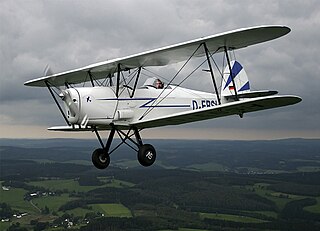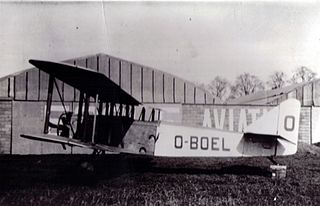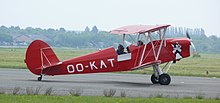
Nieuport, later Nieuport-Delage, was a French aeroplane company that primarily built racing aircraft before World War I and fighter aircraft during World War I and between the wars.

Edmond Thieffry was a Belgian First World War air ace and aviation pioneer. He made, with Léopold Roger and Jef de Bruycker, the first successful flight between Belgium and Congo.

The Stampe et Vertongen SV.4 is a Belgian two-seat trainer/tourer biplane designed and built by Stampe et Vertongen. The aircraft was also built under licence in France and French Algeria.

Aéroplanes Hanriot et Cie. or simply 'Hanriot' was a French aircraft manufacturer with roots going back to the beginning of aviation. Founded by René Hanriot in 1910 as The Monoplans Hanriot Company Ltd. the company survived in different forms until 1916 when it established itself with the Hanriot-Dupont (HD.) fighters and observation aircraft. The company lasted through several takeovers and structural changes until in 1936 it merged with Farman to become the Société Nationale de Constructions Aéronautiques du Centre (SNCAC). 'Central Air Works' consortium.

The Farman F.500 Monitor was a 1950s Franco-Belgian two-seat training aircraft.
The Renard Epervier was a Belgian prototype single-seat all-metal fighter monoplane designed by Alfred Renard at the Societé Anonyme Avions et Moteurs Renard for a government-sponsored design contest in 1928. The Epervier Type 2 was built and flown in 1928, by Belgian aircraft manufacturer Stampe et Vertongen. It carried an armament of two synchronised 7.7mm guns and was lost in September 1928 after failing to recover from a flat spin. A second prototype, the Epervier Type 2bis, introduced revised streamlined fairings for the cantilever mainwheel legs, mainwheel spats and cylinder aft-fairings and was built by SABCA.

The Renard R.35 was a prototype pressurised airliner of the 1930s built by the Belgian aircraft manufacturer Constructions Aéronautiques G. Renard. A three-engined low-winged monoplane with retractable undercarriage, the R.35 was destroyed in a crash on its first flight.
Alfred Renard was a Belgian aviation pioneer.

The Stampe et Vertongen RSV.26/140, RSV.26/180, and RSV.26 Lynx were a family of training biplanes designed by Alfred Renard and built by Stampe et Vertongen in Belgium in the 1920s. They were produced as a response to a requirement by the Belgian Air Force, which became their biggest user, although private owners also bought a small number.

The Stampe et Vertongen RSV.26/100, RSV.18/100, RSV.26/18, and SV.18 were a family of two-seat touring aircraft designed by Alfred Renard and built by Stampe et Vertongen in Belgium in the 1920s and under license by Gates Aircraft in the United States as the Gates Convertiplane. Originally designed as a biplane, a monoplane version soon followed, and the aircraft was eventually marketed as convertible between the two configurations. Sometimes described as a lightened version of the RSV.26/140 military trainer, the RSV.26/100 was actually a fresh design.
The Stampe et Vertongen RSV.22 was a training biplane produced in Belgium in the 1920s.
The Stampe et Vertongen RSV.28/180 Type III, also known as the RSV.28-PSV was a military trainer aircraft built in Belgium to teach instrument-flying techniques. It was a response to a 1929 order from the Belgian Air Force, whose instrument-flying certification required a flight around a 100-kilometre (62 mi) triangular course and return to a point less than 5 kilometres (3.1 mi) from the start, using instruments only.

The Stampe et Vertongen RSV.32 was a trainer aircraft produced in Belgium in the early 1920s. Designed originally for the Stampe et Vertongen flying school, the Belgian Air Force became a major operator of the type, where it became the first aircraft of entirely Belgian design and manufacture to enter service. Many others were purchased by flying clubs and private owners. No RSV.32 was in existence by the end of World War II.

The Stampe et Vertongen SV.5 Tornado was a military trainer aircraft designed and built in Belgium in the 1930s. It saw service with the Belgian Air Force and Latvian Air Force, and Latvian firm VEF purchased a production license, although it is uncertain whether it built any examples.
The Renard R.34 was a 1930s Belgian two-seat biplane trainer designed by Alfred Renard and built by Societé Anonyme des Avions et Moteurs Renard.
The Stampe et Vertongen ST.26 was a 1930s Belgian military blind- and night-flying trainer aircraft.











